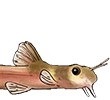The typical sponges filters used are fine pored and when used with a power head they soon fill up with very fine debris which eventually slows the flow through the sponge so much that the vacuum collapses the sponge and they are all but impossible to reuse as power head driven sponge filters again although if cleaned well the OEM sponges may be reused on air lift driven sponge filters.
My standard filter is the Azoo Oxygen Plus Bio-Filter #6.
http://www.fosterandsmithaquatics.com/p ... 41&catid=3
I use 2 per tank sizes 20 to 40 gallons. One is used with the Original Equipment Manufacturer (OEM) fine sponge and is driven by the supplied airlift system.
I use these filters instead of the equivalent HydroSponge IV because the Azoo #6 filter fits directly to the short, tapered extension tubes which come with every MaxiJet Power Head model No.s 400, 600 and 900 which reduces the over all size. I use the model 600 which is rated at a flow of 600 lph/160gph which is plenty of flow for tanks up to 40 gallon breeders.
The powered sponge filter is based on the Bio-Filter #6 frame but I use an open cell structure foam specifically made for aquaculture use and it has 20 pores per inch/2.54 cm. This foam is the same coarse foam that is used in Fluval canister filters except I buy it in a bulk sheet, 1 X 24 X 72 inches.
It is certified safe for fish. No flame retardant or mold resistant chemicals are contained in this filter foam.
One sheet may be cut into 18 pieces 4 X 24 inches; enough for 18 powered sponge filters.
This sheet of foam is sold by aquaticeco.com, product information may be viewed here: http://www.aquaticeco.com/subcategories ... eticulated
This foam works better as it accumulates some debris as all filters do but it will not collapse easily and it is very easily cleaned by rinsing or if like me you are in a hurry, you can blast the dirt out of the foam by using a garden hose nozzle. Here is a photo of one of the strips of filter foam ready for use. This foam is reusable for an indefinite period of time.

The key to what makes these filters so practical is the use of 2-16 inch releasable cable ties. They are reusable for an indefinite period of time I looked far and wide but ultimately I only found them at ULINE.com. Catalog number S-11159NAT

Costs:
A MaxiJet power Head model 600 may be found on sale for about $22.
One 1 X 24 X 72 inch sheet runs $48.00
The 18 sheets/18 filter foams work out to about $2.75 each.
Each OEM equipped Azoo Oxygen plus Bio-Filter #6 run $9.40 each with a fine foam supplied.
The two releasable cable ties cost about $0.20 each X 2 per filter = $0.40/filter.
Here is an assembled power head open cell foam filter. I keep a few extras on hand to speed up routine maintenance.

These are really nice filters for pleco tanks where sometimes a lot of detritus is generated quickly and where you can use all the filtration and water circulation you can get. I normally use mine laid horizontally so the flow is directed across the bottom and it also keeps the power head submerged during 75% water changes. The power heads also have a Venturi Effect aeration feature for those who choose to have additional aeration.
I have been very pleased with how well these filters work. I do use one set up with the OEM fine sponge and running off the airlift for "polishing" the water and additional aeration. Everything is reusable and the only limiting factor is how long the power head lasts. Often it only takes a new $2.75 replacement impeller to get one back up and running but the power head is a machine and therefore can break down eventually but many last 5 to 10 years.
This long life cycle because all the components but the power head last indefinitely you quickly recoup your initial investments.
Each completed filter costs about $33. The only part that can wear out is the power head. Most power heads will last more than 5 years at the least.
If you keep Panaque species you will really appreciate how well these powered sponge filters work but I use them in all my Discus, plecos and fry grow out tanks.




